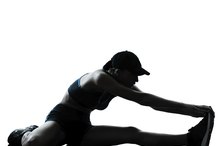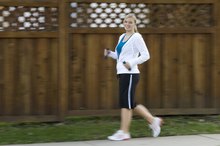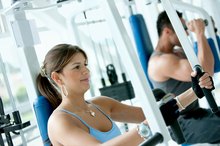What Are Hurdle Stretches?
Hurdle stretches have been used by sports teams and physical education teachers for years to stretch the hamstring muscle. However, this stretch is falling out of favor among coaches and educators because it poses a higher injury risk than other hamstring stretches. If you want to use this stretch, consult a fitness professional and gain instruction on proper form to minimize your injury risk.
Position
To perform a hurdle stretch assume a seated position and extend one knee at a 45-degree angle from your hips, thus resembling the position a track athlete has when clearing a hurdle. Position your other leg straight out in front of you. Reach along your straight leg as far as you can. If you are able to reach your ankles, grab them and relax. Otherwise you grab the farthest point of your leg that you can and relax, advises Andrew Saul, author of “Doctor Yourself.” Hold this position for a count of 25.
- To perform a hurdle stretch assume a seated position and extend one knee at a 45-degree angle from your hips, thus resembling the position a track athlete has when clearing a hurdle.
Risk
Stretching Exercises for ACL Injuries
Learn More
The hurdle stretch carries a higher risk for injury than other stretches do. The hurdle stretch forces sideways motion of your knee joint, which is designed only to flex and extend, according to the “Personal Fitness Looking Good Feeling Great Teacher’s Resource Package,” by Charles S. Williams. The awkward torque on your bent knee places strain on the tendons and ligaments of the joint. Williams recommends using an alternative exercise to minimize injury risk. Safer stretches place your body in a good anatomical position and isolate the muscle you are stretching, according to “The Complete Guide to Running” by Earl W. Fee.
- The hurdle stretch carries a higher risk for injury than other stretches do.
- The hurdle stretch forces sideways motion of your knee joint, which is designed only to flex and extend, according to the “Personal Fitness Looking Good Feeling Great Teacher’s Resource Package,” by Charles S. Williams.
Modifications
You can modify the hurdle stretch to make it safer and less stressful to your knee joint. Instead of assuming a hurdler’s position with one knee bent at a 45-degree angle behind you, fold the leg you are not stretching so that the sole of your foot is tucked against the inside of the thigh on the leg you will be stretching. From there, bend forward to perform the stretch.
Alternative
Tensor Fasciae Latae Muscle Stretches
Learn More
The American Council on Exercise recommends the supine hamstring stretch as an alternative to the hurdle stretch. Perform this stretch by lying on your back and raising one leg so it rests against the edge of a wall. Your other leg lays flat on the floor and is extended past the wall’s edge. Move into a position that lets you rest as much of the rear portion of your elevated leg against the wall as possible. Do not lift your hips form the floor or point your toes up toward the ceiling. Contract your quad muscles as you gently exhale and pull your toes down toward your body without allowing your hips or low back to move, advises ACE.
- The American Council on Exercise recommends the supine hamstring stretch as an alternative to the hurdle stretch.
- Perform this stretch by lying on your back and raising one leg so it rests against the edge of a wall.
Related Articles
References
- “Personal Fitness Looking Good Feeling Great Teacher’s Resource Package”; Charles S. Williams; 2005
- “Doctor Yourself”; Andrew Saul; 2009
- “The Complete Guide to Running”; Earl W. Fee; 2005
- “Coaching Basketball for Dummies”; Greg Bach; 2007
- American Council on Exercise: Modified Hurdler’s Stretch
- American Council on Exercise: What Exercises Can I Do to Alleviate Tight Hamstrings?
- Gage BE, McIlvain NM, Collins CL, Fields SK, Comstock RD. Epidemiology of 6.6 million knee injuries presenting to United States emergency departments from 1999 through 2008. Acad Emerg Med. 2012;19(4):378-85. doi:10.1111/j.1553-2712.2012.01315.x
Resources
Writer Bio
Linda Tarr Kent is a reporter and editor with more than 20 years experience at Gannett Company Inc., The McClatchy Company, Sound Publishing Inc., Mach Publishing, MomFit The Movement and other companies. Her area of expertise is health and fitness. She is a Bosu fitness and stand-up paddle surfing instructor. Kent holds a bachelor's degree in journalism from Washington State University.









